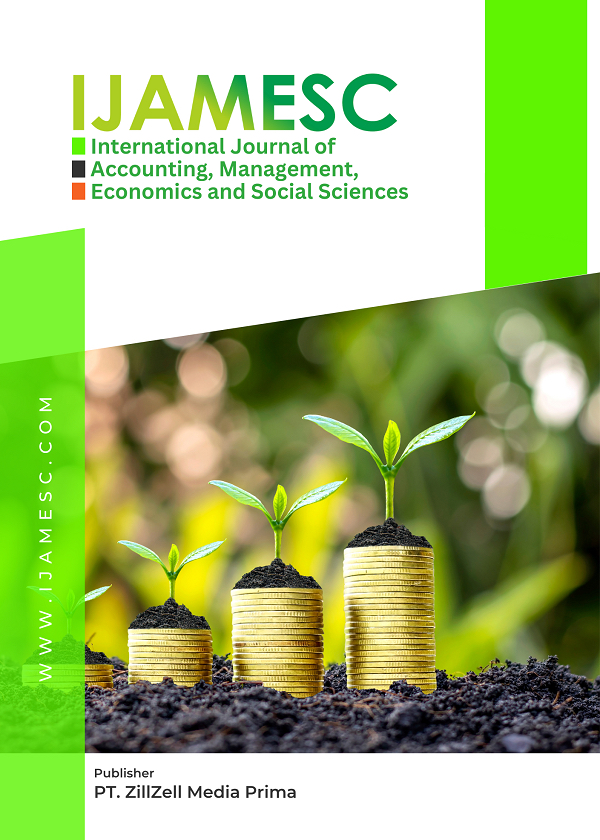CAPITAL MARKET REACTION TO INVESTOR SENTIMENT ON SOCIAL MEDIA: SYSTEMATIC LITERATURE REVIEW
Main Article Content
A. Anggi Reskiamalia
Muh Silmi Kaffa Yusuf
Syarifuddin
Darmawati
This study aims to systematically examine the relationship between investor sentiment on social media and capital market reactions in the context of modern finance. The approach used is Systematic Literature Review (SLR) with reference to the PRISMA guidelines, in order to identify, evaluate, and synthesize the results of previous research that are relevant and indexed in reputable journals. Analysis was carried out on publication trends, geographical context, sentiment analysis methods, and empirical results related to the influence of sentiment on stock prices, volatility, and other market variables. The results of the study show that investor sentiment on social media plays a significant role in influencing the dynamics of the capital market. Information spread through digital platforms such as Twitter, Reddit, and Weibo are able to shape the collective perception of investors which has a direct impact on stock price movements and volatility levels. These influences are heterogeneous, depending on the context of the country, type of industry, and economic conditions. Emerging markets and sectors with low levels of transparency tend to be more sensitive to changes in sentiment than more efficient developed markets. In addition, external factors such as economic crises, pandemics, and government policies strengthen the relationship between sentiment and market reactions. This research provides practical implications for investors in developing strategies based on sentiment analysis, for regulators in designing policies to supervise digital information, and for companies in strategically managing public communications. The next research recommendation is directed at the development of a quantitative model that integrates social media sentiment data with accounting and corporate governance variables to strengthen understanding of market behavior in the digital era.
Aggarwal, A. (2022). The psychological underpinnings of investor sentiment and its impact on market anomalies. Journal of Behavioral Finance, 23(4), 345-362.
Andleeb, S., & Hassan, M. K. (2023). Sectoral susceptibility to social media sentiment: A comparative analysis. International Review of Financial Analysis, 85, 102456.
Awad, M., et al. (2025). The role of social media as a primary channel for shaping investor sentiment in the digital era. Journal of Financial Markets and Technology, 14(1), 78-95.
Ballinari, D., & Behrendt, S. (2021). Sentiment analysis on social media as a proxy for investor behavior. Finance Research Letters, 39, 101597.
Barberis, N., & Thaler, R. (2003). A survey of behavioral finance. In G.M. Constantinides, M. Harris, & R. M. Stulz (Eds.), Handbook of the Economics of Finance (Vol. 1, pp. 1053-1128). Elsevier.
Burra, R. (2024). Amplifying herding: How social media opinions intensify collective behavior and market volatility. Journal of Financial Stability, 60, 101234.
Chaudhary, R. (2025). Methodological challenges in integrating public sentiment analysis with S&P 500 index studies. Journal of Economic Methodology, 32(1), 112-129.
Chen, Y. (2021). The dual transmission channels of investor sentiment in bond markets. Journal of Fixed Income, 31(2), 45-60.
De Sousa-Gabriel, et al. (2024). Crisis-induced amplification: Social media sentiment and volatility in emerging markets and energy sectors. Energy Economics, 129, 105234.
Dzar, M., et al. (2023). Market sensitivity to public information: Evidence from abnormal returns and trading volume activity. Asian Journal of Accounting Research, 8(2), 150-165.
Fama, E. F. (1970). Efficient capital markets: A review of theory and empirical work. The Journal of Finance, 25(2), 383-417.
Fama, E. F. (1991). Efficient capital markets: II. The Journal of Finance, 46(5), 1575-1617.
Feng, Z., & Johansson, A. C. (2019). Executive social media activity on Weibo and firm-specific information content. Pacific-Basin Finance Journal, 57, 101-117.
Ferraro, A., & Sperlì, G. (2024). User-generated content on Twitter and Reddit for stock price prediction through investor sentiment. Expert Systems with Applications, 238, 121801.
Hafidz, A. (2025). Expanding the frontier: Investor sentiment studies in behavioral finance theory. Journal of Financial Research, 48(2), 201-220.
Han, L., & Zhou, X. (2022). Industry susceptibility to investor sentiment: Evidence from social media. Journal of Financial Data Science, 4(3), 78-92.
Hao, Y., Li, X., & Yang, V. (2022). Emerging markets' vulnerability to social media sentiment shocks. Emerging Markets Review, 51, 100876.
Hsu, Y. L., & Tang, Y. C. (2022). The moderating role of the COVID-19 pandemic on the sentiment-stock price relationship. Finance Research Letters, 47, 102656.
Jing, N., Wu, Z., & Wang, H. (2021). A novel stock price prediction method by integrating forum sentiment analysis with technical indicators. Knowledge-Based Systems, 228, 107291.
Joseph, K. (2025). Social informedness and market imbalances: The role of emotional and textual analysis. Journal of Financial Economics, 145(1), 155-175.
Kammoun, I., Power, D. M., & Tandja, A. (2021). Investor sentiment and stock returns in high-risk industries: Evidence from energy and infrastructure. The Energy Journal, 42(5), 1-22.
Karki, M., et al. (2024). Synthesizing empirical findings: The role of systematic review and meta-analysis in social media and market sentiment research. Research Synthesis Methods, 15(2), 89-105.
Kitchenham, B. (2004). Procedures for performing systematic reviews. Keele University.
Kitiwong, D., Ekasingh, E., & Sarapaivanich, N. (2025). The effect of audit policy variations on investor sentiment signals. Journal of International Accounting, Auditing and Taxation, 48, 100525.
Lin, C. (2023). Sentiment sensitivity across economic cycles: A sectoral analysis with focus on the technology industry. Journal of Economic Dynamics and Control, 147, 104589.
Liston-Perez, K., & Gutierrez, L. (2018). Sin stocks and sentiment: A study of investor reaction in controversial industries. Journal of Behavioral and Experimental Finance, 18, 1-9.
Liu, Y., Wu, L., & Li, J. (2019). The social media envy effect on economic expectations and investment behavior. Journal of Economic Psychology, 71, 76-86.
Liu, Y., et al. (2022). The correlation between social media activity and stock price volatility: A global market analysis. Journal of Banking & Finance, 138, 106418.
Lokesh, K. (2022). Market microstructure: The relationship between bid-ask spreads, trading frequency, and price efficiency. Journal of Financial Markets, 25, 100625.
Long, Y., & Guo, J. (2025). Sectoral analysis of sentiment-driven market reactions in the digital age. Journal of Financial Markets, 68, 100845.
Long, Y., et al. (2023). The GameStop phenomenon: Positive sentiment on r/WallStreetBets and its impact on stock price. Journal of Behavioral Finance, 24(3), 345-360.
López-Cabarcos, M. Á., & Pérez-Pico, A. M. (2020). The influence of cognitive and emotional biases on investment decisions. Frontiers in Psychology, 11, 1639.
Madani, H. H., et al. (2020). Market reaction to stock split events: Evidence from abnormal returns, trading volume, and bid-ask spreads in Indonesia. Journal of Asian Business and Economic Studies, 27(2), 123-140.
Maghyereh, A. I., Awartani, B., & Abdoh, H. (2020). The impact of investor emotions on crude oil returns. Energy Economics, 91, 104870.
Mansley, N., Wang, S., Weng, L., & Zhang, Y. (2023). Rational responses? A comparison of REITs and high information asymmetry sectors to social media sentiment. The Journal of Real Estate Finance and Economics, 66(4), 567-589.
Niţoi, M., & Pochea, M. M. (2020). Collective sentiment and cross-market correlations in Europe during crises. Economic Modelling, 89, 233-245.
Nyakurukwa, K., & Seetharam, Y. (2023). The mobilization of retail investors: A bibliometric analysis of online forums and stock price movements. Journal of Behavioral and Experimental Finance, 37, 100785.
Olanrewaju, F., et al. (2024). Big data analytics and machine learning in analyzing social media-driven investor behavior. Journal of Financial Analytics, 2(1), 45-67.
Page, M. J., et al. (2021). The PRISMA 2020 statement: An updated guideline for reporting systematic reviews. BMJ, 372, n71.
Prasad, S., et al. (2022). Divergent paths in sentiment measurement: Textual linguistics versus machine learning. Journal of Financial Econometrics, 20(3), 445-470.
Rasyid, R., et al. (2024). Investor sentiment as an early warning indicator for potential market crises. Journal of Financial Stability, 62, 101245.
Rodríguez-Ibáñez, M., & Casánez-Ventura, A. (2023). Sentiment analysis from social media for understanding collective behavior patterns in stock price fluctuations. Computational Economics, 61(2), 543-567.
Riyanto, R., et al. (2024). Tick price mechanism, high-frequency trading, and market efficiency in the Indonesian capital market. Asia-Pacific Financial Markets, 31(1), 45-67.
Thirumala, S., et al. (2025). The interplay of fundamental and psychological factors in capital market dynamics. Global Finance Journal, 53, 100725.
Ugurlu-Yildirim, E., Kocaarslan, B., & Ordu-Akkaya, B. M. (2020). Monetary policy uncertainty, investor sentiment, and stock prices. The North American Journal of Economics and Finance, 54, 101258.
Vuong, T. H., & Suzuki, Y. (2022). A comparative study of market reactions to social media sentiment in developed and emerging markets. International Journal of Finance & Economics, 27(4), 4125-4143.
Zatira, S., et al. (2022). The influence of stock prices, trading volumes, and return volatility on bid-ask spreads: Evidence from LQ45 companies. Journal of Indonesian Economy.






































